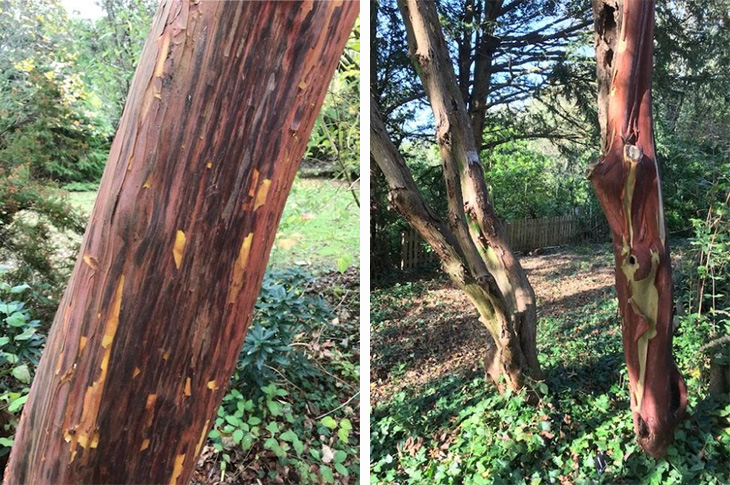This month Mark Emery, a Friend of Highdown Gardening Volunteer, has written about the Arbutus x andrachnoides, or most commonly known as the Strawberry Tree.
Strawberry Tree: Arbutus x andrachnoides
Location at Highdown: Opposite the front of the Visitor Centre and Performance Area
Species from the genus Arbutus commonly known as Strawberry Trees are represented at Highdown by several closely related specimens. Arbutus x andrachnoides, the Hybrid Strawberry Tree, is pleasing to the eye throughout the gardening year.
It has glossy dark evergreen foliage, with white or pink pitcher-shaped flowers borne in autumn and winter. A mature specimen can produce small strawberry-red fruits, giving it its common name. The fruits are orbicular in shape and smaller than a strawberry.
Its most outstanding feature is its flaking bark in varying shades of cinnamon-brown, providing striking colour all year round, especially in autumn and winter. The bark has a beautiful warm glow when bathed in sunlight. Classed as a shrub or small tree it can reach 12m in height. The plant is tender when young but hardy when mature.
Photos: the Arbutus x andrachnoides opposite the the Visitor Centre (Credit: Mark Emery)

There are several examples of Arbutus growing at Highdown:
Arbutus x andrachnoides is to be found on the lawn opposite the new Visitor Centre. It’s the smallest of two but still striking in appearance and not dissimilar to Acer griseum, the Paper Bark Maple.
An additional and stunning mature specimen of Arbutus x andrachnoides can be found east of the Performance Area of the lower garden.
Arbutus x andrachnoides is a hybrid between Arbutus unedo the Strawberry Tree and Arbutus andrachne its Grecian relative, the two parent plants stand together left of the visitor centre.
Photos (credit: Mark Emery):
(left) bark of the Arbutus x andrachnoides in the Performance Area
(right) trunks/bark of the Arbutus unedo and Arbutus andrachne

Frederick Stern mentions the Grecian Strawberry Tree in his book A Chalk Garden:
A. andrachne is also well, now about 16ft high with charming downy-grey bark turning red. The seed was sent to us in the 1920s by S. C. Atchley from Greece. So it seems that several of the Arbutus do not mind calcareous soil although they belong to Ericaceae. P.183
Atchley was a British diplomat and botanist, one of many early plant collectors who contributed seeds collected from foreign habitats to Stern. In 1938 The Wild Flowers of Attica by Atchley was published, Attica being the ancient Greek name for Greece. These collaborations were directly responsible for many of the unusual plants growing at Highdown. Early plant collectors and experimental gardeners such as Stern were pioneers in introducing many of the plants we grow in our gardens today.
Stern began his garden against the advice of some experts, given that Highdown consists of a few inches of topsoil resting upon the solid chalk of the South Downs. As a true adventurer and man of imagination he persisted and succeeded gloriously. In the above quote from Stern we learn that the plant belongs to the botanical family Ericaceae, which normally indicates an intolerance for alkaline soils and a liking for acidity. Stern further writes:
A. andrachne was raised from seed from Greece, and it’s growing on the edge of the Downs, making a bush with a lovely smooth reddish bark and deep green entire leaves. P.159
I first came across the Strawberry Tree at Mewsbrook Park in Littlehampton. There are also some fine specimens of Arbutus x andrachnoides adjacent to the bridge that crosses the river Arun as you enter the West Sussex town of Arundel.